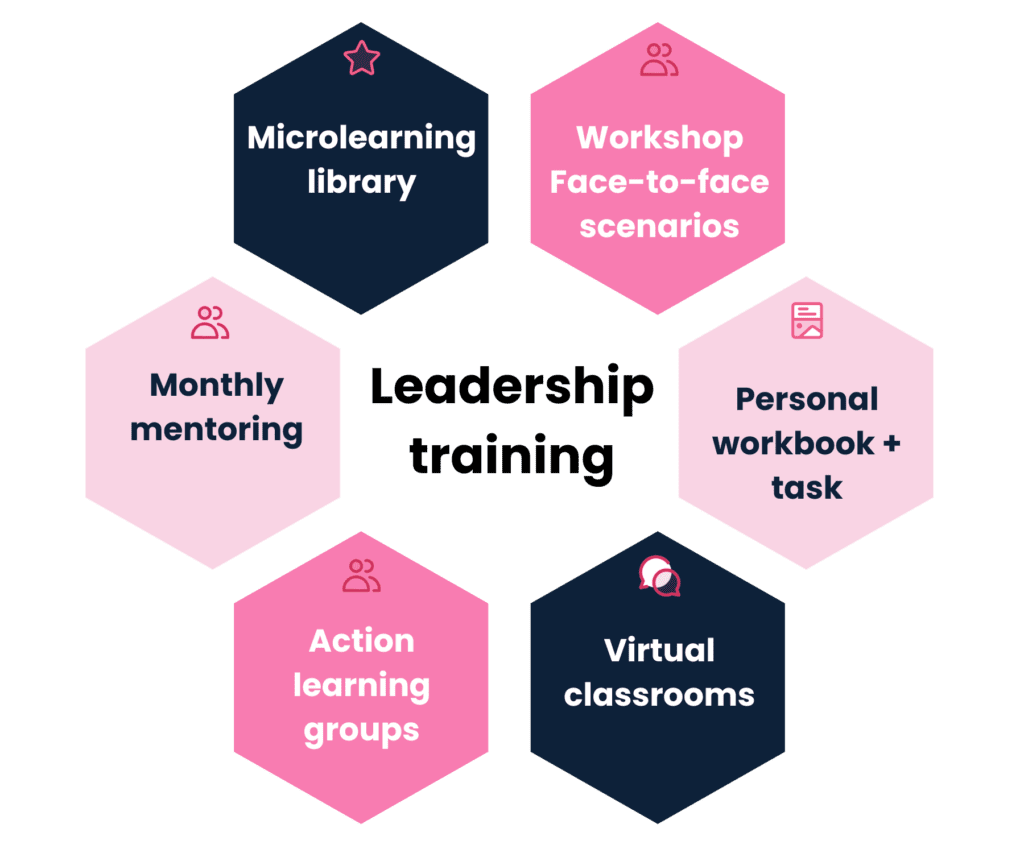How to build an effective blended learning strategy (with examples)
7 minute read
Blended learning isn’t new, but it’s never been more relevant for workplace learning. With today’s dispersed teams, varied job roles, and rising pressure to deliver real business results, blended learning offers one of the most effective ways to support performance and growth at scale.
In this article, we’ll explore what blended learning is, why it works, common pitfalls to avoid, and practical ways to implement it. We’ll also share real-world examples and advice tailored to busy learning managers and content authors. So read on for how you can create performance-enhancing blends.

Table of contents
What is blended learning?
Blended learning is an approach that combines multiple formats and channels – from elearning and face-to-face sessions to coaching, on-the-job tasks, social learning, and more – to help people learn and apply new skills more effectively.
It’s not about format for format’s sake. At its best, blended learning is a response to real workplace needs – offering the right support, in the right way, at the right time to drive performance and behavior change.
What goes into a blend depends on the objectives of the learning. Sometimes it’s a simple combination – for example, adding a coaching conversation as a follow-up to elearning. In other cases, it could involve a full program made up of virtual classrooms, peer groups, independent assignments, job aids, and microlearning modules.
Traditionally, blended learning meant pairing elearning with face-to-face training, often using a flipped classroom model. Learners would complete some pre-work online, attend a live workshop, then apply what they’d learned through a follow-up activity.
Today, blended learning has evolved.
With more digital tools available, hybrid working models, and a stronger focus on personalization, learning blends can now be delivered entirely online or through a mix of digital and human touchpoints. That might include:
- Online chat forums (e.g. Slack, Teams)
- Virtual coaching or mentoring
- Peer-led discussion groups
- Microlearning and elearning
- Video explainers and interactive scenarios
- Job aids, checklists, and digital toolkits
- On the job practice tasks and demos
The key? Every element should serve a purpose. Blended learning works best when each piece is chosen to meet people where they are and help them take the next step forward.
What are the benefits of blended learning?
It’s not just about creating variety for variety’s sake. Done well, a blend can:
- Support real-world behavior change: Blends connect learning to the flow of work – so people can build confidence over time and apply knowledge in the moment.
- Offer flexibility for time-poor teams: Especially important for customer-facing or shift-based roles where time is tight and access to online learning may be limited.
- Caters to different needs and contexts: Field teams, desk-based roles, senior managers – they all have different working patterns. Blended learning gives you more ways to reach them effectively.
- Improves engagement and depth of learning: Live interactions, peer conversations, and practice all help embed knowledge and build skills that stick.
- Build accountability: A key insight from our roundtable – when people know their learning will be discussed or acted on later, they take it more seriously.
As one learning manager told us, “You work harder at your learning when you know someone will follow up, ask questions, or care about what you think.”
Common mistakes with designing blended learning
Designing effective blends isn’t just about using lots of formats. Watch out for these traps:
- Spamming learners across too many channels: Choice is good. Overload isn’t. Good blends require being intentional.
- Lacking cohesion: Each element of your blend should add something new and link clearly to the big picture. The key messaging can be repeated, but the parts of the blend should build upon one another to create cohesive learning.
- No clear purpose or performance focus: Don’t build a beautiful blend around content. Start with what people need to do differently, and what activities or practice will help them get there.
- No follow-up: If there’s no feedback loop or sense that learning will be seen, it’s easy to disengage – especially for remote or shift-based employees. Solo learning, even with a blend, can be lonely.
Best practice strategies for creating blended learning
Here’s a round-up of the strategies that work best when it comes to designing blended learning.
- Design backwards from the behavior or outcome: What does ‘better’ look like on the job? How can we best support that and help people make the change?
- Use channels learners already access: If Teams or Slack is popular, that’s a great place to drop in nudges and reminders. If regular ‘lunch-n-learns’ already exist, how can you utilize those? Don’t try to bring people to a whole new place or channel – that’s an uphill battle!
- Blend human and digital: Self-paced content builds foundation, but reflection and discussion drive deeper learning, and accountability.
- Keep touchpoints short, purposeful, and well spaced: Think of the blend as a campaign, not a course.
- Introduce light-touch accountability: A chat, a nudge, a quick reflection – not always a full workshop.
- Respect people’s time and context: A good blend supports performance without adding stress.
Why driving accountability is key to effective blends
Without accountability, learning often slips down the list. On the flip side, if you know you need to present something, discuss your learning with a coach or manager, or take part in a role play activity with your team – you’re likely to get focused!
Blended learning’s secret power is when it brings in an element of accountability.
You don’t need lengthy workshops or formal assessments to create accountability. Even a short, well-timed nudge, a check-in, or a manager-led huddle can provide that vital ‘moment that matters’.
The key is choosing the right kind of follow-up – something light, practical, and supportive – that helps people apply what they’ve learned and shows that it matters.
One Elucidat customer shared a novel approach to bring accountability and ownership to product training:
“We gave staff new products and asked them to share videos of their experience. It exploded! They owned the learning – it felt real.”
Blended learning examples
Example 1 – A product training blend for sales teams
Context: A new product line is launching in retail stores. Staff need just enough product knowledge and confidence to talk to customers – fast.

The blend:
- 10-minute elearning module with visuals and voiceover, accessible on mobile.
- Printed handout or break-room poster with FAQs and messaging.
- Store manager huddle guide: a 5-minute discussion with questions and a “tell me one thing you learned” round-robin.
- Sales practice session in pairs, during downtime, with a peer
- Manager observations on the job or of practice sessions
- Feedback: managers pick 1-2 team members per week to demo how they would sell the new product, and get feedback.
Why it works:
- Doesn’t take staff off the floor for long.
- Multiple access points (phone, paper, team chat).
- Light accountability via peer conversation and a manager follow-up.
- Keeps the focus on application and customer conversations, not just content.
Explore examples of how elearning can be used to support product training here.
Example 2 – A Leadership development blend
Context: A program for emerging people managers in a global organization.

The blend:
- Microlearning topics on key leadership topics, accessible anytime
- A workshop that focuses on working through scenarios collaboratively
- A personal digital workbook to prompt self-reflection and log tasks completed
- Live virtual sessions with peer breakout discussions and role-play scenarios
- Action learning groups to explore real-world challenges together
- Monthly manager nudges and feedback prompts
- Optionally – add in an applied project, shared with senior leaders at the end of the program
Why it works:
- Flexible formats for busy schedules
- Builds knowledge, skills and confidence over time
- Encourages reflection, connection and conversation
- Adds weight through senior leader visibility and real-world application
The future of blended learning
As organizations look ahead, blended learning is set to become even more dynamic and data-driven.
New technologies from AI-powered coaching to smarter learning analytics are enabling more personalized, in-the-flow experiences. We’ll likely see:
- More intelligent blends: Content recommendations based on role, goals and behavior patterns.
- AI-facilitated reflection and nudging: Helping learners stay engaged and accountable in the moment.
- Integrated tools and channels: Breaking down silos between LMSs, authoring platforms, and workflow platforms.
- Greater emphasis on skills and outcomes: With talent marketplaces and skill data rising, blends will align more closely with business capability-building.
What won’t change? The need for thoughtful, people-centered design. However advanced the tech becomes, effective blends will always start with understanding your audience: their needs, their context, and their challenges.
Conclusion – what to take away
A great blend doesn’t just deliver learning. It supports people to perform, grow and connect – over time.
That means being strategic. It means building in reflection and accountability, even in small ways. And it means designing for real people, not ideal circumstances.
Start simple. Test and evolve. And always keep the learner’s world at the heart of your design.
Interested to learn even more about how to design effective learning programs? Check out our elearning best practice guide.You can also subscribe to our Learning at Large newsletter for monthly inspiration from the front line of L&D.




